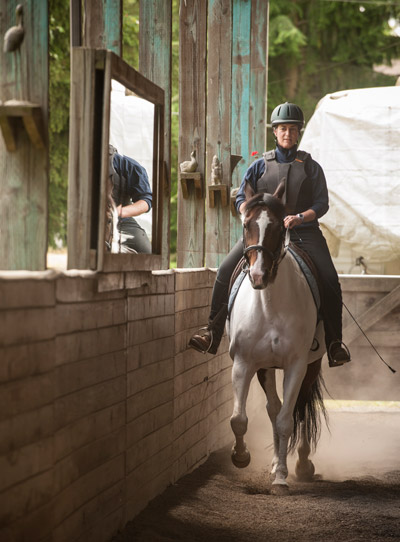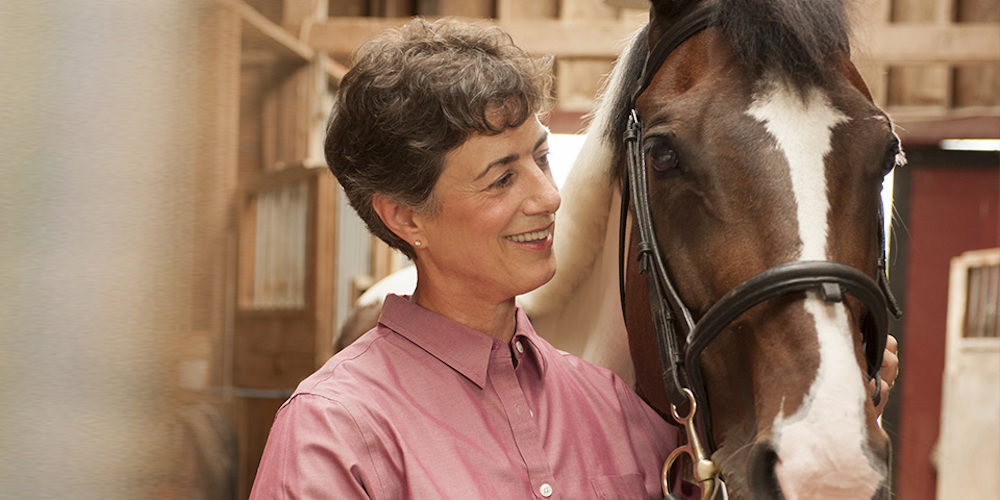“CandiGirl knew something was wrong—she’s like a 1400-lb. mood ring. When I have tension or anxiety, she reacts to it,” says Diana as she gently wipes her horse’s ears, as if caring for a young child, then bends down to lift the horse’s leg and clean her hooves. “She likes it (the grooming). How she reacts tells me about her day. It not only improves the quality of her coat, but it improves our relationship.”
 Just a few months before, hefting saddles, carrying feed, leading CandiGirl over uneven pasture, riding and even grooming—it all became nearly impossible for Diana as she suffered from a degenerated hip. To cope with the increasing pain, she stashed ibruprofen everywhere, so she could access a dose when she needed to. “I really thought that I would do physical therapy for six weeks and be better,” she says. Most likely the result of a teenage riding accident that never properly healed, Diana’s doctor determined that her right hip was bone-on-bone from her accident-altered gait and needed replacement.
Just a few months before, hefting saddles, carrying feed, leading CandiGirl over uneven pasture, riding and even grooming—it all became nearly impossible for Diana as she suffered from a degenerated hip. To cope with the increasing pain, she stashed ibruprofen everywhere, so she could access a dose when she needed to. “I really thought that I would do physical therapy for six weeks and be better,” she says. Most likely the result of a teenage riding accident that never properly healed, Diana’s doctor determined that her right hip was bone-on-bone from her accident-altered gait and needed replacement.
“It’s important to ride in a state of relaxation,” says Diana, “with the legs draped on the horse’s sides. Before (replacement) surgery, my whole body was tense because of my hip, with everything connected to it in spasm. My right foot never pointed straight. Even putting my right foot in the stirrup was challenging. Now, my legs drape and I can ride with stability and confidence which helps me relax, and CandiGirl too. See that?” she asks, as she smoothly glides her right foot into the stirrup. After her ride, Diana buoyantly swings off CandiGirl and lands on both legs, pointing out her solid dismount as another exciting post-surgery accomplishment. “I’m really surprised at how quickly it’s all come together, and wonder why people put off surgery.”
“Not that I wanted a new hip,” says Diana, “but I wanted my life back. I wanted to ride CandiGirl. Garden. Go for a long walk with my husband. In September, once I learned I needed surgery, I scheduled mine as soon as possible, which was right before Christmas. It turned out to be the ‘BEST CHRISTMAS EVER,’” she says with a laugh, for the opportunity to stay quietly at home with an easy chair, fireplace and beautifully decorated tree.
“I started with an inclination to go to Valley, and thorough research supported the conclusion that I would have a good outcome. I liked all the people I had interacted with at Valley and figured if a staff of that high caliber could work anywhere and they all chose Valley, that says a great deal about the administration that put such an incredible institution like The Joint Center into place. To be able to go to a Joint Center that specializes in replacements and has never really had ‘sick’ patients in it, lessening my chance of infection, is a great thing. People I know and respect who can go where ever they want to, choose Valley. I was particularly interested in the research that Dr. Barrett participated in, that showed anterior approach offered a shorter recovery time and more mobility, faster. When I first met with Dr. Barrett, he said he had done over 400 anterior approaches. The combination of information told me everything I needed to know. Valley Medical Center is tremendous and its doctors and staff are tremendous. I’m so lucky to have a world-class team of people around me: my husband James, my (horse) trainer, my vet, my physical therapist, and the care at Valley and its staff.
“Yesterday I had my first riding lesson in more than a year. Even after the lesson I kept riding. And then came home, worked in the yard a bit, played with the puppy and did some baking. That hasn't happened for years. I would have come home from the barn and sunk into an easy chair to rest. My life just keeps getting better!”
Specific Raves about Valley Medical Center and The Joint Center
 The STAR Center, Valley’s pre-surgery check-up location, has a busy and efficient staff who are genuinely kind and never rushed through our appointment. They know what they’re doing and care about it, which makes such a huge difference in your peace of mind.
The STAR Center, Valley’s pre-surgery check-up location, has a busy and efficient staff who are genuinely kind and never rushed through our appointment. They know what they’re doing and care about it, which makes such a huge difference in your peace of mind.
The surgery tracking system is great for waiting family. It was such a relief for my husband to know where I was each step of the way through the surgery process by watching the patient tracking monitor.
Rooms are restful. The rooms are very comfortable and well laid out. So clean. I loved the translucent doors—they helped the staff not have to flick on the lights every time they came into the room. The whole floor doesn’t really even look like a hospital.
Nurses were really focused on my care. When I rang the buzzer, they came quickly. They remembered that I don’t like ice in my water. Pain management was very good—the nurses were empowered to make adjustments to my medications to keep me more comfortable. They were so skilled, kind and generous.
Valley listens and responds to suggestions. After surgery, constipation is an issue. I thought it might help to add prunes as a menu option and I suggested it to my doctor. When I came back for a follow-up appointment, he let me know the prunes had been added to the menu.
Diana’s Tips for Making the Most of Post-Replacement Physical Therapy
When you decide to get a joint replacement, DO IT ALL! Get the physical therapy you need to be able to have a normal gait and do the life activities you want with ease. Squeeze the most training you can out of therapy. There’s lots of work to do to get things firing normally again if you’ve gone years compensating for a degenerated joint.
Find a therapist you have confidence in, one that will help you refine the skills to do all the little things important to your daily life.
Meet with your therapist before surgery to learn how to use your walker. Walker tip: If you’re out and about with your walker and need to use a toilet with no handrails, turn your walker backwards and place it over the toilet, using the walker as your handrails to sit down and get back up.
Keep up with your exercises even after therapy is over to keep flexible and strong.


